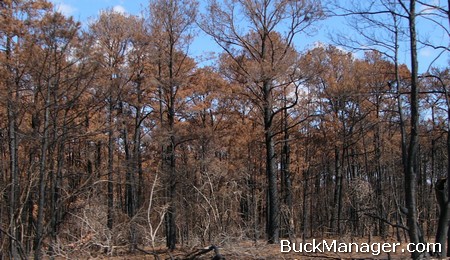All wildlife species need food, cover, water and space to survive. White-tailed deer are no different. Most regions of Texas have been pretty thin on food and water for wildlife this year due to pitifully low amounts of rainfall, but many properties have been impacted by wildfires too, consuming dry vegetation (food and cover) and completely setting back white-tailed deer habitat. Burned lands can look bad, real bad at first. However, the benefits of fire on native habitats have been well documented.
Fires used for habitat management purposes are always prescribed fires, not wildfires. Prescribed burns differ greatly from wildfires in that planned fires can be set to accomplish specific objectives. This is not the case with wildfires, which can also destroy homes and other valuable infrastructure. But from a habitat perspective, fire is fire. The plant communities found in Texas are well-adapted to fire. But what can properties impacted by recent wildfires expect?

With all of the brush and old-growth trees found across the state we sometimes forget that most of Texas is located in the Great Plans of North America. Wildfires were an important natural process in the region that curtailed the widespread growth of trees and brush. With Texas’s white-tailed deer population hovering around four million animals for several decades now, it’s hard to imagine a time when whitetail were not numerous in the Lone Star State. But it’s true. As wildfires were controlled, buffalo and pronghorn habitat soon gave way plant communities more suited to white-tailed deer.
But whitetail, like other game and non-game animals found across the state, are also adapted to to fire. In fact, deer do great in habitats that have been recently burned. This is especially true in areas where head fires have not completely removed all hardwood trees. With “normal” rainfall events, habitat can bounce back within a matter of weeks, if not days. Properties recently burned, however, are suffering from low soil moisture and a drought that has yet to really break.
Source: “Deer pushed out of burned areas and relocated to adjacent land face problems unless the burned areas begin recovering quickly. Drought has so severely reduced forage that the wildlife already on the land is having a tough time getting enough to eat. Adding more mouths on already stressed land means less food for all of them. Also, with so little grass on the landscape and with hay prices through the roof, cattle are eating the browse they usually ignore, competing with whitetail deer on burned lands.
This year’s drought and hot temperatures appear also to have greatly reduced the acorn crop on which so much wildlife depends later in the year.”
White-tailed deer habitat is greatly improved through fire. New shrub, forb, and grass sprouts use the abundance of nutrients released into the soil after a fire. These new-growth plants are more nutritious and palatable to deer than older plants. Deer that inhabit burned lands will ultimately benefit from high quality habitat loaded with forage, but the population could suffer in the interim. Properties recently burned should consider removing all livestock, even if recent rains have caused the green-up of grasses. Livestock grazing will only further impact already stressed plants. This could be detrimental to native grasses and browse species, which are particularly important to deer, without at least some deferment from grazing.

From a deer management point of view, fire is a great tool. Fires allow areas to be “born again” and they promote flower, seed, and fruit production. This increases available mast (fruits and nuts) for for deer, but much of that forage will not be available for deer until next Spring. Winter is just around the corner and acorn production has been lackluster. This fat-rich food is a seasonally important food for whitetail deer, but it’s not available to them this year. Landowners interested in carrying whitetail through the winter should consider the supplemental feeding of deer. Pelleted feeds with a minimum 16 percent protein are sufficient.
An important aspect of habitat is soil. Without soil, plant growth will suffer big time. The removal of excessive brush by fire will allow more sunlight to hit the ground. This will promote more forbs and grasses to grow when it rains, but until that happens these areas will be nothing more than dirt. Bare ground—another reason livestock should be removed from areas impacted by fires, especially in areas with steep slopes. Hoof action will do nothing but loosen soils. A heavy downpour will then cause severe erosion. A good soil and habitat management practice under these conditions would be to overseed the area with cool season annuals, such as ryegrass, and hope for several small rainfall events to get these plants established to stabilize the soil.
Lastly, deer density is important, especially on properties that have recently had fires run across them. Forb, grass and most browse species will survive and begin to bounce back, but too many animals will stunt their effort. In addition, attempting to maintain too many animals is always a bad idea for deer management. Unless environmental conditions change rapidly in the short term, it appears all wildlife species will be facing a hard time this winter. Deer population reduction could be one of many management strategies to consider post-fire.
I have a few burn piles on my property in Hardin County- Lumberton, Texas. I have 12 does and bucks coming on my property to feed every day/night. Sometimes after I burn a pile of brush the deer will eat the ash and graze on burned limbs. All year round. Why is that?
Kenneth, whitetail and other wildlife are wired to find the resources they need within the area they live. The deer in your area are looking for something specific, and this article was written to address your question. Thanks for your question.